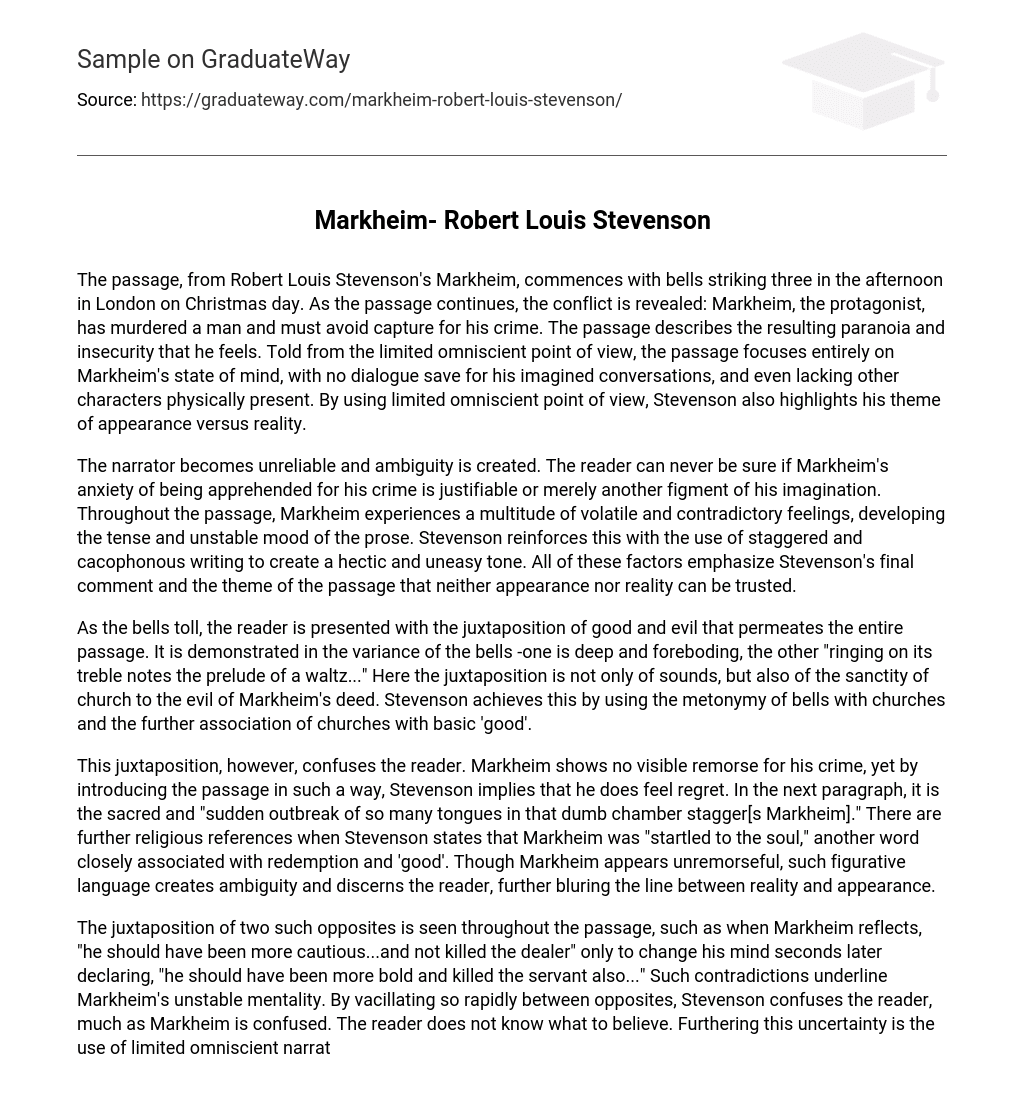The text from Robert Louis Stevenson’s Markheim begins with the sound of bells striking three in the afternoon in London on Christmas day. As the passage continues, it reveals the conflict faced by the protagonist Markheim, who has committed murder and must now avoid being caught for his crime. The passage describes Markheim’s heightened sense of paranoia and insecurity. It is narrated from a limited omniscient point of view, solely focusing on Markheim’s state of mind. There is no dialogue except for Markheim’s imagined conversations and no other physical presence of characters. By adopting this limited omniscient point of view, Stevenson emphasizes the theme of appearance versus reality.
The narrator in the passage creates ambiguity and makes the reader unsure if Markheim’s fear of getting caught for his crime is valid or imaginary. Markheim goes through various conflicting emotions, contributing to the tense and unstable mood of the writing. Stevenson uses staggered and cacophonous writing to enhance the hectic and uneasy tone. These elements emphasize Stevenson’s main point and the passage’s theme: one cannot rely on either appearance or reality.
The passage presents a contrast between good and evil through the tolling of bells. The bells are described as having different tones – one is ominous while the other is like a waltz. This juxtaposition symbolizes the contrast between the church’s sanctity and Markheim’s evil act. The author employs metonymy to connect the bells with churches, further emphasizing their association with goodness.
In the text, the reader is confused by the contrast between Markheim’s lack of remorse for his crime and Stevenson’s suggestion of his feeling regret. This confusion arises when the passage introduces the sacred and sudden outbreak of voices in the silent chamber, which causes Markheim to stagger. The mention of Markheim being startled to the soul also relates to religious connotations of redemption and goodness. Despite Markheim’s seemingly unremorseful demeanor, this figurative language creates ambiguity that confuses the reader and blurs the distinction between reality and perception.
Throughout the passage, the juxtaposition of opposites is evident. For instance, Markheim initially reflects on how he should have been more cautious and not killed the dealer, but seconds later he changes his mind and declares that he should have been more bold and killed the servant as well. These contradictions highlight Markheim’s unstable mentality. By rapidly vacillating between opposites, Stevenson confuses the reader, much like how Markheim is confused. The reader is uncertain of what to believe. Adding to this uncertainty is the use of a limited omniscient narrator. Being inside Markheim’s mind, the narrator also becomes unreliable. The narrator cannot recount objectively, but instead must convey the emotions exactly as Markheim feels them. As a result, the reader is unsure if Markheim’s anxiety of being apprehended is justified or just a figment of his imagination.
In Markheim’s fear of noise and “the swift transition of his terrors, [where] the very silence of the place seemed a source of peril…”, a significant juxtaposition is observed. This contradiction between noise and silence serves as an example of Stevenson’s use of sensual imagery to captivate the reader. When the bells ring in the first paragraph, the reader’s auditory senses are instantly engaged. This heightened sensual awareness can be viewed as a means to monitor Markheim’s own alertness. Even though Markheim is alone in the shop, his senses are so heightened that he can seemingly hear a faint noise of someone walking above him in the rest of the house.
The unreliability of reality and appearance is highlighted through the sensual imagery in Stevenson’s work. If one believes in the solipsistic philosophy, their own senses should be trustworthy. However, in this passage, Markheim’s senses deceive him and make him believe in something that is not true. In the second paragraph, his unreliable senses are exposed when he sees multiple reflections of himself in many mirrors. It is impossible for there to be more than one Markheim, but he perceives multiple versions of himself. The repetition of his face in the mirrors intensifies his sensory confusion, as does the repetition of the word ‘repeated’. This endless cycle creates further confusion for both Markheim and the reader.
Stevenson intentionally creates confusion in order to demonstrate his theme that both reality and appearance are untrustworthy, and this is conveyed through his tone. The sentences vary in length, with some being short and choppy while others extend for nearly seven lines, punctuated with semicolons and colons. The phrases blend together, blurring the distinction between what is real and what is merely an illusion. Markheim’s state of mind is portrayed as hazy and indistinct, reflecting the style of writing.
Markheim is situated in a London antique shop, mirroring the plot. The foggy day, gray and dusty shop setting reflects the stillness that repeatedly haunts Markheim, evoking deathly thoughts. The silence and aged nature of the antiques only intensify Markheim’s paranoia, making him believe he will inevitably be apprehended. Furthermore, his isolation within the antique shop pits him against the external world, heightening the tension.
Markheim is uncertain if he will be apprehended for the murder he has committed, which is the focal point of his inner turmoil. The reader’s uncertainty about the validity of Markheim’s suspicions stem from the use of unclear language, an untrustworthy narrator, and perplexing sentence structure. Markheim himself is also unsure, as he experiences hallucinations and frequently changes his thoughts, mirroring the reader’s confusion. It is through this fog that Stevenson conveys his theme – the unreliability of both surface appearances and actuality.





